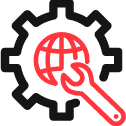LLM Optimization (LLMO) has grown faster into a new frontier for digital marketers who want to stay visible in an AI-driven search world. Traditional SEO strategies focused on keywords and backlinks, but LLMO needs a complete transformation in content structure, presentation, and distribution across the web.
Large language models now shape search results, and content creators must adapt their methods. The LLM algorithm powering tools like ChatGPT, Gemini, and DeepSeek processes information differently than regular search engines. It prioritizes context, relevance, and authority through complex LLM parameters. Modern LLM optimization goes beyond simple keyword placement and focuses on detailed entity relationships. Traditional llm seo tactics often fail without understanding the mechanisms that power these sophisticated systems.
This detailed guide covers everything from simple LLMO concepts to advanced implementation strategies. You will find ways to structure content for maximum LLM visibility and build brand authority signals that LLMs recognize. The guide shows how to measure optimization success through emerging analytics approaches. You will also learn practical techniques that position your content as the authoritative source LLMs reference when they respond to user questions.
Understanding LLM Optimization and Its Role in Modern Search
Large language models have altered the map of the digital world. This new reality demands a fresh approach to online visibility that goes beyond traditional search techniques. A new discipline has emerged that focuses on capturing AI’s attention.
What is LLMO, and how is it different from traditional SEO
Large Language Model Optimization (LLMO) helps content appear in answers that AI tools like ChatGPT and Perplexity generate. LLMO aims to ensure that AI systems reference your brand and content when responding to user questions, rather than just ranking on search engine results pages.
The core differences between LLMO and traditional SEO include:
- Business model move: LLMs use subscription-based models instead of ad revenue, which changes how information reaches users
- Content structure: LLMO needs semantically complete content chunks rather than keyword-focused pages
- Authority sources: LLMs prefer credible third-party citations and websites, with the core team as gatekeepers
- Content format: LLMs can parse Q&A formats, listicles, and wiki-style pages more easily
- Focus: LLMO emphasizes brand context, natural language, and complete topic coverage instead of keyword repetition
LLMO puts emphasis on how AI systems understand, interpret, and reference content through intent optimization, semantic relationships, conversational patterns, and citation-worthy structures.
Why LLM optimization matters in 2025 and beyond
Users now turn to AI platforms more often to find information, which makes LLMO increasingly vital. Research shows generative AI traffic expanded by an extraordinary 1,200% between July 2024 and February 2025. A Cornell University study suggests LLMs are taking over traditional SEO as users choose generative engines for individual-specific results.
The data highlights this trend’s momentum:
- Semrush’s research shows that AI search visitors will exceed traditional search visitors by 2028
- Google’s search market share fell below 90% in October 2024 for the first time since March 2015
- AI Overviews appeared in 42.51% of search results in Q4 2024
- Gartner predicts LLMs could lead to a 50% decrease in search traffic
Traditional SEO alone can’t ensure content visibility and discovery as AI chatbots gain market share.
The rise of LLMs like ChatGPT, Gemini, and DeepSeek
Major LLMs compete in an evolving landscape, with several key players dominating different markets. ChatGPT leads with 79.8% of global AI chatbot referral traffic. The platform serves about 600 million monthly users as of March 2025.
Google’s Gemini (formerly Bard) serves 350 million monthly users, yet claims only 2% of global chatbot traffic. Its AI Overviews reached 1.5 billion monthly users at 2025’s start.
DeepSeek has emerged as a strong competitor, especially in China, where it holds 89.3% market share. This two-year-old company gained impressive traction and became the most downloaded free app in both the US and UK, with 12 million downloads in just 2 days.
The search landscape’s fragmentation shows users feel comfortable with AI-powered information retrieval on multiple platforms. This represents the biggest change in information discovery since Google’s original algorithm appeared.
How LLMs Process and Interpret Content
LLMs need a deep understanding of their inner workings to create an effective LLMO strategy. These sophisticated systems interpret information through complex mechanisms that work quite differently from traditional search algorithms.
Tokenization and vector mapping in LLM algorithms
LLMs start by breaking text into smaller units called tokens. These tokens represent words, subwords, or character sets based on the tokenization method. GPT models use Byte-Pair Encoding (BPE) to handle various linguistic elements efficiently. The model assigns each token a unique ID and represents text as sequences of numerical values.
The model turns these tokens into multi-dimensional vector embeddings. These vectors capture word meanings by plotting them as points in a high-dimensional space. This mathematical representation helps LLMs understand concept relationships without explicit programming.
Semantic space and contextual prediction
LLMs excel at traversing semantic space—a mathematical realm where similar words cluster together. The transformer architecture’s self-attention mechanisms help these models spot patterns and relationships between concepts. Words derive their meaning from the surrounding context, which enables deeper understanding.
In-context learning gives LLMs the power to extract information from user prompts without retraining. Models make better predictions by processing examples in the prompt. Quality matters more than quantity—relevant examples yield better results than additional context.
Retrieval-Augmented Generation (RAG) for real-time data
RAG enhances LLM capabilities by linking them to external knowledge sources. This system works in two steps: it retrieves relevant information from external databases and incorporates this data into the generation.
RAG offers these advantages:
- Current, reliable facts beyond training data
- Verifiable sources for content
- Fewer hallucinations and inaccuracies
- No need for frequent model retraining
RAG lets LLMs work like students consulting reference materials instead of relying on memory alone. Vector databases store document embeddings and match queries with relevant information through semantic similarity.
Limitations of static training data in LLMs
LLMs face major constraints because of their static training data. These models learn from data snapshots at specific times and cannot access newer information. They cannot learn new knowledge after their original training phase.
Computational boundaries also restrict LLMs with fixed token limits on context processing. Exceeding these limits (like GPT-3’s 4096 token maximum) leads to truncation or errors, making it hard to process long documents.
These constraints show why techniques like RAG have become vital for accurate, current responses without complete model retraining.
Core Tactics to Optimize Content for LLMs
Your content’s success in LLM results depends on specific writing and formatting tactics. These proven techniques can help your content get cited more by AI systems.
Writing clear, concise answers in conversational tone
Content with a conversational tone engages both human readers and AI tools better. LLMs are trained on natural language and prefer content that follows human-like dialog patterns. You can make your content more personal by using first-person pronouns like “we” or “you”. This helps you avoid formal phrasing that sounds robotic.
Princeton researchers found that AI tools, such as ChatGPT, rephrase content with clear questions and direct answers 40% more often. Each section should begin with a direct answer, followed by supporting details. LLMs process information better with this top-loaded structure.
Using consistent terminology and brand phrases
LLMs can link your brand to specific topics better when you keep your terminology consistent. One expert says, “If you’re known for LLM Optimization, talk about LLMO in most of your relevant articles”. Your brand connects to key concepts through this repetition.
Marketing language can create confusion. Your content works better with concrete details and verifiable information that models use for accurate responses.
Incorporating statistics and quote-worthy data
Quote-worthy content and statistics boost your citation chances. Websites gain 28-40% more visibility in LLMs just by adding credible content. Cornell University research shows that “GEO methods that inject concrete statistics lift impression scores by 28% on average“.
Key points for statistics:
- Use exact numbers instead of general claims
- Add the year with statistics
- Make statistics stand out (bold, callouts)
- Credit all sources
Structuring content with FAQs and direct answers
FAQs play a vital role in LLM optimization. Users query AI systems in ways that match FAQ structures, which makes your content more likely to appear in generated responses. Questions should match exactly how users ask them, with both simple and complex variations (how/what/why/when).
Data Science Dojo research proves that clear formatting helps LLMs understand and extract information better. This includes headings, bullet points, and numbered lists. Complex ideas need to be broken into smaller sections since LLMs read pages in blocks that must make sense on their own.
Building Brand Authority for LLM Visibility
Your brand’s authority signals across the web directly affect how LLMs recognize and recommend your content.
Digital PR and topic association strategies
Digital PR forms the strategic foundation for creating brand-topic associations in the LLM era. Your business information should match exactly across all online platforms. Building expertise through expert commentary in industry publications and sharing knowledge on professional platforms comes next. AI systems learn more about your expertise from each online mention, which creates a purposeful presence that makes your brand the natural choice for AI-generated recommendations.
Backlink profile optimization for trust signals
Quality backlinks show LLMs that your brand appears in credible places across the internet. This digital goodwill signals to AI systems that you’re a respected voice in your field. You should focus on:
- Editorial links that naturally mention your brand in context
- Links from sites likely included in LLM training data
- Diverse anchor text with both branded and topical terms
Entity research using NLP tools and anchor text analysis
Entity research helps LLMs understand your brand beyond keywords. Structured entity relationships enhance visibility in AI-driven search. Google NLP Explorer, InLinks, or Wikidata can help you assess how AI understands your content. Schema markup helps confirm your brand’s identity and helps AI systems interpret your content accurately.
Using Reddit and UGC platforms for organic mentions
Reddit has become an optimization powerhouse and ranks as the #1 cited domain in AI-generated responses across millions of prompts. Reddit threads exist in AI training data—your post today might become part of ChatGPT’s answer tomorrow. Upvotes signal authority to AI and serve as indicators of trust and relevance. Brands with strong community presence receive more favorable mentions in AI-generated answers, which makes authentic participation vital.
Creating a Wikipedia page to boost credibility
Wikipedia stands as one of the most important training sources for large language models. A Wikipedia page requires meeting strict notability standards through third-party coverage from journalists, researchers, and industry experts. Your Wikipedia presence needs ongoing attention to accuracy and neutrality, and all changes must have support from reliable sources.
Tracking LLM Mentions and Measuring Optimization Success
Tracking how well your LLM optimization works needs specific ways to track that go beyond regular analytics. You cannot know if your optimization strategies work without measuring them properly.
Using GA4 and regex filters to track LLM traffic
Google Analytics 4 lets you measure visits from AI platforms through a dedicated segment. The process starts with an exploration report in GA4. Next, you can use this regex filter to spot AI referrals: ^.*\.openai.*|.*copilot.*|.*chatgpt.*|.*gemini.*|.*gpt.*|.*neeva.*|.*perplexity.*|.*claude.*. This pattern spots traffic from major LLMs and filters out regular sources.
These metrics matter most for analysis:
- Session source/medium (shows which LLM sent the traffic)
- Engagement rate and how long sessions last
- Conversion events from AI-driven visits
Asking LLMs what they think about your brand
LLMs can tell you a lot about how your brand comes across. Recent numbers show LLMs shape brand choices for half of 18-24-year-olds and 53% of 25-34-year-olds. On top of that, 35% of people expect LLMs to help them find products or services.
Your brand questions to LLMs should check:
- How consistently they describe your brand
- What topics and qualities do they link to your company
- Which competitors do they mention with your brand
Monitoring brand mentions in ChatGPT and Gemini
New tools help track brand mentions across LLM platforms systematically. SE Ranking’s visibility trackers for ChatGPT and Gemini show how often AI responses include your brand. These tools check mention frequency, context, website links, and your standing against competitors.
The monitoring should focus on:
- How often you’re mentioned (visibility score)
- What people think (positive/neutral/negative mentions)
- Related topics (themes linked to your brand)
Preparing for the upcoming LLM rank tracking tools
The world of LLM tracking grows faster with smarter tools. Platforms like Nightwatch, Profound AI, Rankscale, and Scrunch AI offer special features to improve AI visibility. These tools analyze prompts that mention your brand, check if you’re a cited source, and compare your visibility with competitors.
The best tools should give you:
- Monitoring across major LLMs
- Visibility trends over time
- Ways to measure against competitors
- Data-based suggestions for improvement
Your Next Step in LLM Optimization Strategy
Your LLM optimization journey should begin with practical steps that strike a balance between existing SEO efforts and new approaches. Google still drives the majority of website traffic, but AI platforms are rapidly changing how people find information. A strategy that evolves in manageable phases is the most sensible approach.
Testing one technique at a time is more effective than changing everything at once. You should identify which platforms matter to your audience – pick either ChatGPT, Perplexity, or Google AI Overviews. The next step is to check your brand’s presence on primary citation sources like Wikipedia, Reddit, and reputable industry websites.
Your most valuable content needs optimization first:
- Days 1-30: Conduct baseline testing with 25 key industry questions, implement simple schema markup, and add clear TL;DR sections to top articles
- Days 31-60: Reformat top articles with proper heading hierarchies, add FAQ sections to high-traffic pages, and boost content with current statistics
- Days 61-90: Develop complete Q&A-formatted guides, create informed resources, and document which formats perform best
Results tracking requires referral monitoring in GA4 for AI platform traffic. Regular testing of the same questions in ChatGPT helps measure improvement over time. Large-scale LLM deployments can be expensive—up to $20 million per day for major financial institutions. This means focusing your efforts where they’ll deliver the most value.
Success depends on visibility metrics rather than just traffic. Brand mention frequency, citation quality, and share of voice in AI-generated content need constant monitoring.
Key Takeaways
LLM Optimization (LLMO) represents a fundamental shift from traditional SEO, requiring content creators to adapt their strategies for AI-powered search platforms that prioritize context, authority, and conversational formats over keyword density.
- LLMO differs fundamentally from SEO: Focus on conversational tone, direct answers, and semantic completeness rather than keyword optimization for AI citation success.
- Structure content for AI parsing: Use FAQ formats, clear headings, and quote-worthy statistics to increase your 40% likelihood of being referenced by LLMs.
- Build authority through diverse mentions: Leverage Reddit, Wikipedia, and high-quality backlinks as trust signals, as LLMs heavily weight credible third-party citations.
- Track AI traffic with specialized tools: Set up GA4 regex filters and monitor brand mentions across ChatGPT, Gemini, and other platforms to measure the success of optimization.
- Start with high-value content first: Test LLMO techniques on your most essential pages using a phased 90-day approach rather than overhauling everything at once.
With generative AI traffic expanding 1,200% and predictions that AI search will surpass traditional search by 2028, implementing LLMO strategies now positions your brand as the authoritative source that AI systems reference when responding to user queries.
FAQs
What is LLM Optimization, and how does it differ from traditional SEO?
LLM Optimization (LLMO) focuses on making content visible to AI-powered search tools like ChatGPT and Gemini. Unlike traditional SEO, LLMO emphasizes clear, conversational content with direct answers and comprehensive topic coverage rather than keyword repetition. It also prioritizes building authority through credible citations and structured data.
How can I structure my content to improve visibility in LLM-generated responses?
To improve LLM visibility, structure your content using FAQ formats, clear headings, and bullet points. Include concise, direct answers at the beginning of each section, followed by supporting details. Incorporate relevant statistics and quote-worthy data, and maintain a conversational tone throughout your content.
What are some effective strategies for building brand authority in the eyes of LLMs?
To build brand authority for LLMs, focus on consistent digital PR efforts, optimize your backlink profile with quality links, and leverage user-generated content platforms like Reddit. Creating a Wikipedia page for your brand can also significantly boost credibility. Additionally, use schema markup to help AI systems better understand your brand’s identity and expertise.
How can I track the success of my LLM optimization efforts?
Track LLM optimization success by setting up regex filters in Google Analytics 4 to capture AI-driven traffic. Monitor brand mentions and sentiment across major LLM platforms using specialized tools. Regularly query LLMs about your brand to gauge perception. Keep an eye on emerging LLM rank tracking tools that offer competitive benchmarking and visibility trend analysis.
What’s a practical approach to start implementing LLM optimization?
Begin by focusing on your most valuable content. Implement basic schema markup and add clear TL;DR sections to top articles. Gradually reformat content with proper heading hierarchies and FAQ sections. Create comprehensive Q&A-formatted guides and data-driven resources. Track results using GA4 and regular testing in ChatGPT. Start with one platform (e.g., ChatGPT or Google AI Overviews) and expand your efforts over time.










